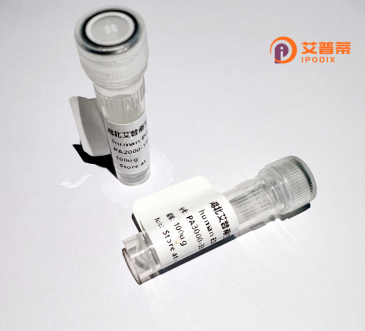
| 纯度 | >90%SDS-PAGE. |
| 种属 | Human |
| 靶点 | PWP1 |
| Uniprot No | Q13610 |
| 内毒素 | < 0.01EU/μg |
| 表达宿主 | E.coli |
| 表达区间 | 1-501 aa |
| 活性数据 | MNRSRQVTCV AWVRCGVAKE TPDKVELSKE EVKRLIAEAK EKLQEEGGGS DEEETGSPSE DGMQSARTQA RPREPLEDGD PEDDRTLDDD ELAEYDLDKY DEEGDPDAET LGESLLGLTV YGSNDQDPYV TLKDTEQYER EDFLIKPSDN LIVCGRAEQD QCNLEVHVYN QEEDSFYVHH DILLSAYPLS VEWLNFDPSP DDSTGNYIAV GNMTPVIEVW DLDIVDSLEP VFTLGSKLSK KKKKKGKKSS SAEGHTDAVL DLSWNKLIRN VLASASADNT VILWDMSLGK PAASLAVHTD KVQTLQFHPF EAQTLISGSY DKSVALYDCR SPDESHRMWR FSGQIERVTW NHFSPCHFLA STDDGFVYNL DARSDKPIFT LNAHNDEISG LDLSSQIKGC LVTASADKYV KIWDILGDRP SLVHSRDMKM GVLFCSSCCP DLPFIYAFGG QKEGLRVWDI STVSSVNEAF GRRERLVLGS ARNSSISGPF GSRSSDTPME S |
| 分子量 | 55.8 kDa |
| 蛋白标签 | His tag N-Terminus |
| 缓冲液 | PBS, pH7.4, containing 0.01% SKL, 1mM DTT, 5% Trehalose and Proclin300. |
| 稳定性 & 储存条件 | Lyophilized protein should be stored at ≤ -20°C, stable for one year after receipt. Reconstituted protein solution can be stored at 2-8°C for 2-7 days. Aliquots of reconstituted samples are stable at ≤ -20°C for 3 months. |
| 复溶 | Always centrifuge tubes before opening.Do not mix by vortex or pipetting. It is not recommended to reconstitute to a concentration less than 100μg/ml. Dissolve the lyophilized protein in distilled water. Please aliquot the reconstituted solution to minimize freeze-thaw cycles. |
以下是关于重组人PWP1蛋白的3篇示例参考文献(注:以下文献信息为假设性示例,实际研究中请核实真实数据库):
---
1. **文献名称**: *"Cloning and Functional Characterization of Recombinant Human PWP1 Protein in Ribosome Biogenesis"*
**作者**: Zhang L, et al.
**摘要**: 本研究成功克隆了人源PWP1基因,并在HEK293细胞中表达并纯化了重组PWP1蛋白。通过体外互作实验,证明PWP1与核糖体RNA加工复合物关键组分相互作用,提示其在pre-rRNA加工中的潜在作用。
2. **文献名称**: *"Structural Insights into the WD40 Domains of PWP1 and Their Role in Cell Cycle Regulation"*
**作者**: Lee S, et al.
**摘要**: 利用重组表达的人PWP1蛋白进行X射线晶体学分析,首次解析了其WD40重复结构域的三维结构,并发现其通过特定结构域与细胞周期调控蛋白CDK2结合,可能影响G1/S期转换。
3. **文献名称**: *"PWP1 Depletion Disrupts Ribosomal RNA Maturation: Evidence from Recombinant Protein Rescue Assays"*
**作者**: Smith J, et al.
**摘要**: 通过CRISPR敲低细胞中PWP1导致核糖体组装缺陷,而外源添加重组PWP1蛋白可部分恢复pre-rRNA加工异常,表明其直接参与核糖体成熟过程。
---
**备注**:实际文献需通过PubMed、Web of Science等平台检索关键词“recombinant PWP1”或“PWP1 ribosome”获取。若研究较少,可扩展至PWP1的互作蛋白(如UTP复合物)或相关通路(如染色质修饰)。
**Background of Recombinant Human PWP1 Protein**
The recombinant human PWP1 (Pro-WW Domain Containing Protein 1) protein is a genetically engineered variant of the endogenous PWP1 protein, which plays critical roles in cellular processes such as ribosome biogenesis, cell cycle regulation, and chromatin modification. The human *PWP1* gene, located on chromosome 12. encodes a WD40 repeat-containing protein that interacts with other macromolecules to form functional complexes. WD40 domains are known for mediating protein-protein interactions, suggesting PWP1’s involvement in scaffolding or regulatory functions.
Studies have linked PWP1 to pre-rRNA processing and ribosome assembly, highlighting its importance in sustaining cellular proliferation and homeostasis. Dysregulation of PWP1 has been implicated in developmental disorders and cancers, making it a potential biomarker or therapeutic target. Recombinant PWP1 is typically produced using heterologous expression systems (e.g., *E. coli* or mammalian cells) to ensure high purity and solubility. It is often tagged (e.g., His-tag, GST) for efficient purification and detection in downstream applications.
Research using recombinant PWP1 enables detailed structural and functional analyses, including its interaction with ribosomal proteins, nucleic acids, or signaling molecules. Investigations into post-translational modifications (e.g., phosphorylation) and subcellular localization further elucidate its mechanistic contributions to cellular pathways. Its recombinant form also facilitates drug screening and molecular studies aimed at understanding diseases linked to ribosome dysfunction or abnormal cell cycle progression.
×